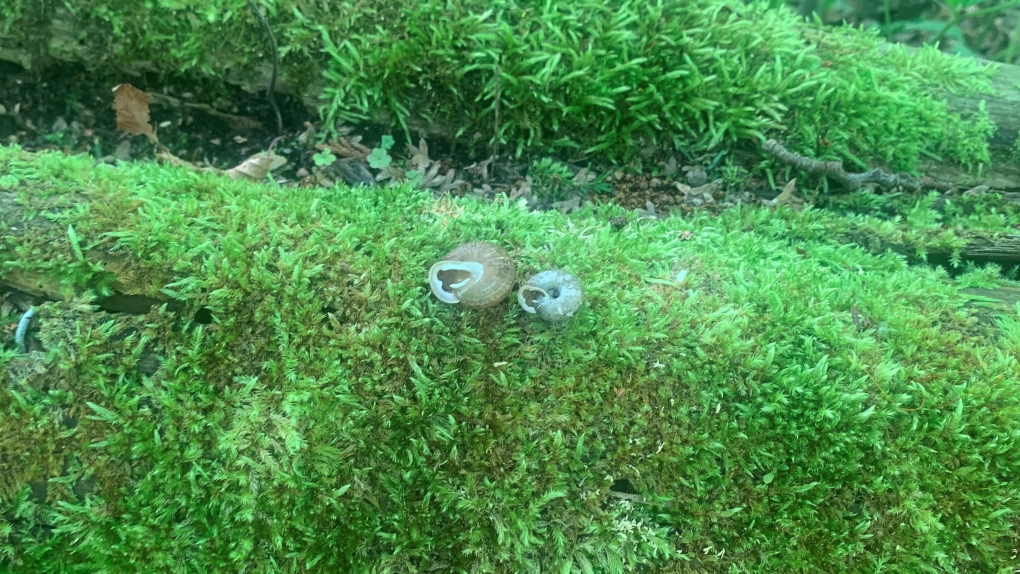Biologist discovers rare snail near Woodstock, Ont.
Species at Risk Biologist with the Upper Thames River Conservation Authority, Scott Gillingwater is very passionate about his work.
So much so, he and his wife, purchased 55 acres of wetlands and woodland near Woodstock in 2019 to ensure it would be protected for years to come.
Gillingwater lives and works on the property known as Snake Woods Nature Preserve (SWNP), which is provincially protected property as an area of natural scientific interest and also as significant wetland.
Last year, while doing research in the SWNP forest, he discovered something rare.
"It was actually by chance find, we were doing salamander surveys and I noticed an interesting looking snail,” said Gillingwater as he walked down a tree-lined forest holding the shell of a shagreen snail.
"The shagreen can be identified by these three teeth like objects on the opening of the shell,” explained Gillingwater.
The observation was first made in April 2023, corrected a year later via iNaturalist, a mobile app that connected Gillingwater with international experts who specialize in Canadian snails.
The shagreen snail is endangered both provincially and federally.
 Shagreen snails were found in Snake Woods Nature Preserve near Woodstock, Ont. (Reta Ismail/CTV News London)"We kind of look at the shagreen as the canary in the coalmine, of that indicator species, that if something is impacting the most sensitive species, how long is it going to take before more resilient species to start to be impacted?” said Gillingwater.
Shagreen snails were found in Snake Woods Nature Preserve near Woodstock, Ont. (Reta Ismail/CTV News London)"We kind of look at the shagreen as the canary in the coalmine, of that indicator species, that if something is impacting the most sensitive species, how long is it going to take before more resilient species to start to be impacted?” said Gillingwater.
Snake Woods Nature Preserve could be home to the last remaining mainland population of the rare snail in Canada, as their population has dwindled due to habitat loss.
Gillingwater said they have documented over 1700 species of plants and animals on the SWNP.
“Including some exceptionally rare moths, there’s one called Reversed Haploa Moth, very, very rare in Ontario. We get some rare migratory birds that do some stopovers on the property, number of plants, as well as we have good populations of some of our reptiles amphibians that are found in this region,” explained Gillingwater.
He continues to conduct research on his property and hopes one day to leave it all behind as a legacy for years to come.
"When it's time for us to go, hopefully donate that property to ensure it's protected forever,” said Gillingwater.
CTVNews.ca Top Stories

Job losses and killer robots: The 'Godfather of AI' describes plenty to fear, but there may be room for hope
University of Toronto computer scientist Geoffrey Hinton describes plenty to fear with AI, but with visions of combat drones, mass surveillance and robot overlords ahead, there may be space for hope.
'I'm sorry, I'm just frustrated': Video appears to show man spit on MP
A video circulating online appears to show MP and former cabinet minister Marco Mendicino get spat on while on his way into a government building in Ottawa.
4 people found dead in southwestern Ontario town of Harrow
Ontario Provincial Police are investigating after four people were found dead in the town of Harrow, just south of Windsor. Officers were called to a residence on County Road 13 at approximately 1:30 p.m. on Thursday.
More than 100 stolen vehicles recovered in auto theft probe involving ServiceOntario employee: Toronto police
Toronto police say they have arrested four suspects and recovered more than 100 stolen vehicles as part of a months-long auto theft probe that involved a former ServiceOntario employee.
EXCLUSIVE 'We were in danger': Timmins, Ont., manhunt prompts questions from cottagers near shootout
Cottagers who live near the area where murder suspect Lucas MacDonald was captured say they didn't realize how much danger they were in.
Car dealerships in Canada, U.S. disrupted by multi-day outage after cyberattacks
CDK Global, a company that provides software for thousands of auto dealers in the U.S. and Canada, was hit by back-to-back cyberattacks on Wednesday. That led to an outage that continued to impact many of their operations on Friday.
Shiny monolith removed from mountains outside Las Vegas. How it got there is still a mystery
A strange monolith found jutting out of the rocks in a remote mountain range near Las Vegas has been taken down by authorities.
It's the longest bridge ever built in Peru, and so far, it goes nowhere
It is the longest bridge ever built in Peru, a massive structure of cement and iron spanning the Nanay River as it connects to untouched areas of the Peruvian Amazon. So far, it goes nowhere.
Skin cancer signs: How can you tell if a suspicious spot is serious?
Doctors say changes in the skin are normal as you age, from spots of various colours to dark streaks in nails. But sometimes, they're not innocuous.






























